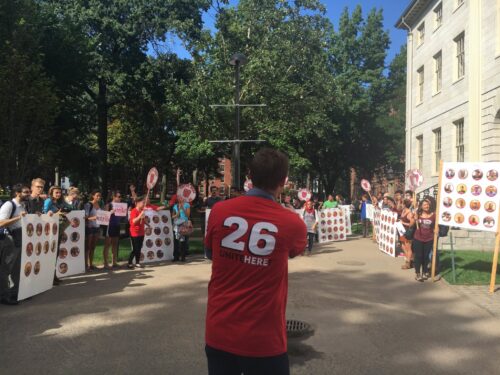HUDS and students rally as strike vote approaches.
On Wednesday September 7th, dozens of members of the Harvard and greater Boston community gathered in a side room of University Lutheran Church to hear from HUDS workers and their allies about the impending worker’s strike. It was a warm afternoon. Members of the standing-room-only crowd fanned themselves and drank bottles of water from the cases provided. Many students proudly sported Harvard gear—a subversive means of signaling their opposition to the University’s current treatment of its staff.
Harvard dining hall workers will vote today on whether or not to strike. This vote comes after months of contract negotiations between HUDS workers and the University. Between the beginning of negotiations in June and now, Harvard has failed to address worker’s concerns regarding affordable healthcare and a yearly living wage. According to the Facebook page of Harvard’s Student Labor Action Movement, or SLAM, “Harvard recently raised a record $7 Billion…[but] refuses to guarantee a sustainable income…to all of its employees.”
According to Camille Traslavina ’18, a member of Harvard’s Student Labor Action Movement, or SLAM, who spoke at the rally, “Concretely, HUDS workers are asking for year-round work for those who need it, and to not have their affordable healthcare taken from them. In doing so, the workers are also fighting for basic dignity and respect, and a Harvard that centers and cares for its students, workers, and faculty, the people who make up this community.”
Support for the strike does extend into the community beyond Harvard. Brian Lang, the president of Local 26, the union of which HUDS workers are members, spoke at the Wednesday rally. Lang spoke to the problems with Harvard’s priorities—that its endowment could fund the government of the city of Cambridge for decades, yet it refuses to pay its dining hall workers enough to live in the city in which they work.
Anabela A. Pappas, a Cabot and Pforzheimer House dining hall worker, opened up about her personal investment in healthcare. “As a diabetic for 35 years,” she said to the crowd in University Church, “I’ve never been so scared in my life. And I shouldn’t have to be scared working for Harvard dining service.” Her speech, like so many others given that day, was met with applause and cheers from the crowd.
And indeed, Pappas has reason to be afraid. Under Harvard’s proposed healthcare plan, co-pays would increase drastically, jumping from $40 to $100 for an emergency room visit. For workers who are making less than $35,000 a year with no overtime, an increase in the cost of necessary healthcare has the potential to be highly detrimental to the health of Harvard workers. “With its resources and visibility, Harvard has the opportunity to be a leader and serve as a model for other universities,” says Traslavina, “demonstrating that relationships between institutions and their employees do not have to be exploitative, and setting an expectation that universities have a responsibility to care for all members of their communities.”
Following the gathering at the church, hundreds marched with signs, posters, and large boards sporting faces of 600 HUDS workers from every part of the university through Harvard Square. The call-and-response chants of the group ranged from the broad—“No justice, no peace”—to the specific—“Hey Harvard you can’t hide, we can see your greedy side.” A fellow protestor remarked as we lined the iron fence around the yard “Is there any other side?”
As the vote on whether to strike approaches, “SLAM is prepared to follow the workers’ lead and assist them in whatever ways they believe will be most helpful,” says Traslavina. The value of such support was evident at Wednesday’s rally. Along with SLAM, representatives from the Harvard Islamic Society, the Medical School’s Racial Justice Coalition, and the Harvard Students Union-UAW spoke in support of HUDS workers. The medical students, who showed up sporting lab coats, were held up by HUDS and union leaders as representatives of the health impacts of Harvard’s policies, while undergrads represented the community of which HUDS is a vital part.
From the beginning of freshman year, HUDS workers are some of the people students first meet and some of the faces Harvard students see most frequently. John in Annenberg seems to learn every freshman’s name and greet them each time they come in for a meal. HUDS workers keep us fed, ask us how our days are going, and show us kindness, often when we most need it. The student presence at the rally and growing support for the strike is proof of the truth in one particular protest chant that rang through the yard on Wednesday—“when Harvard workers are under attack, what do we do?
Stand up. Fight back.”
Megan Sims (megansims@college.harvard.edu) is grateful for HUDS workers and hopes that you will lend your support to the strike. tinyurl.com/supportthestrike







